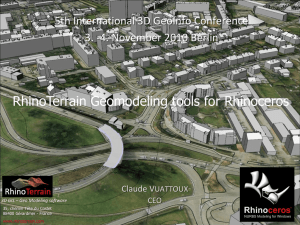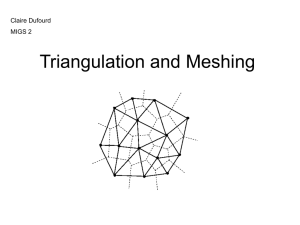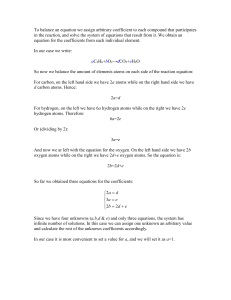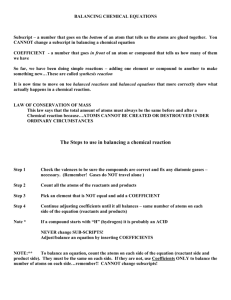Paper
advertisement
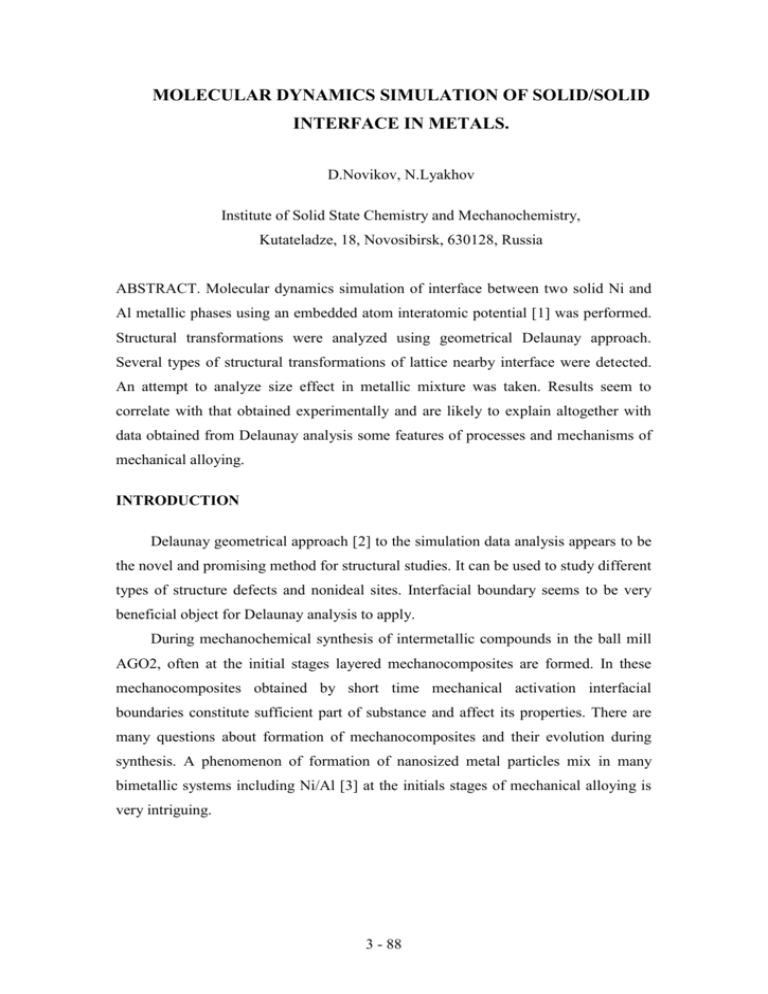
MOLECULAR DYNAMICS SIMULATION OF SOLID/SOLID
INTERFACE IN METALS.
D.Novikov, N.Lyakhov
Institute of Solid State Chemistry and Mechanochemistry,
Kutateladze, 18, Novosibirsk, 630128, Russia
ABSTRACT. Molecular dynamics simulation of interface between two solid Ni and
Al metallic phases using an embedded atom interatomic potential [1] was performed.
Structural transformations were analyzed using geometrical Delaunay approach.
Several types of structural transformations of lattice nearby interface were detected.
An attempt to analyze size effect in metallic mixture was taken. Results seem to
correlate with that obtained experimentally and are likely to explain altogether with
data obtained from Delaunay analysis some features of processes and mechanisms of
mechanical alloying.
INTRODUCTION
Delaunay geometrical approach [2] to the simulation data analysis appears to be
the novel and promising method for structural studies. It can be used to study different
types of structure defects and nonideal sites. Interfacial boundary seems to be very
beneficial object for Delaunay analysis to apply.
During mechanochemical synthesis of intermetallic compounds in the ball mill
AGO2, often at the initial stages layered mechanocomposites are formed. In these
mechanocomposites obtained by short time mechanical activation interfacial
boundaries constitute sufficient part of substance and affect its properties. There are
many questions about formation of mechanocomposites and their evolution during
synthesis. A phenomenon of formation of nanosized metal particles mix in many
bimetallic systems including Ni/Al [3] at the initials stages of mechanical alloying is
very intriguing.
3 - 88
THEORY
Some features of Delaunay approach to the interfacial interatomic configuration
analysis are listed below.
For the structure analysis methods based on Delaunay triangulation were used.
Lately this method is widely used for studying dense solids and liquids. In the present
work the system under investigation was divided into quadruples of points – the
simplexes of Delaunay, arranged in such a manner that no point of system is inside
the circumsphere of any simplex, and simplexes fulfill whole space of the system
without superpositions and interstices. In the perfect BCC lattice such simplexes are
perfect tetrahedron and quadrahedron (a quarter of perfect octahedron). Measure to
evaluate the similarity of simplex shape to perfect tetrahedron can be introduced in the
following way [4]:
T=
(li - lj)2/(15 <l>2), where i<j.
Or perfect quadrahedron:
O=
(li - lj)2/(10 <l>2) +
(li – lm/1.1415)2/(5 <l>2), where i<j; i, j
m;
Where li – lateral length of Delaunay simplex, lm – longest lateral length of
quadrahedron simplex, <l>=(1/4)*
(li), where i = 1 to 4. The less magnitude of that
measures the closer shape of the simplex to perfect one.
It is useful to declare measure S, characterizing the perfectness of simplexes:
S = min (T, O).
This measure is used in present work for structure analysis.
A center of simplex is equal to the center of its circumsphere.
In the current research several free programs were used: Qhull [5] for
computation of Delaunay triangulation, and Rasmol [6] for visualization.
RESULTS AND DISCUSSION
Several systems were modeled and analyzed.
In the first model an intermixing of Ni and Al atoms was observed using a
special function taking in account atom type of geometrical members of Delaunay
triangulation. A number of Ni atoms to have minimal number of Ni neighbors and
3 - 89
maximum number were computed. A system for analysis was constructed in a very
simple manner. A cube in periodical boundary conditions of aluminum lattice (FCC,
{100}, a = 0.4049 nm) with an edge of x was created, and then a smaller cube with an
edge of x/2 was extracted from it and filled with Ni atoms (FCC, {110}, a = 0.3524
nm). Afterwards the system was quenched, relaxed and heated.
For a number of systems with x = 1.6; 2.4; 2.8; 3.2 nm computations were made.
A smallest one with an edge of 1.6 nm was exposed at several temperatures. In the
temperature range of 630-690K fast intermixing of metal atoms was detected. The
temperature 630K was chosen as basic one, as it is sufficiently lower than the melting
temperature of Ni and Al phases, and it is reachable in the course of mechanochemical
synthesis.
All four systems were exposed at the temperature of 630 K for a period of about
one nanosecond. A function characterizing a depth of intermixing was constructed
with the use of Delaunay graph. Number of atoms to have many Ni neighbors (almost
pure Ni) and a few (mostly Al) was calculated. See Fig. 1.
1,0
Function of distribution of Ni neighboring atoms
at 630 K for systems of diffrernt sizes
Y, Relative friqency of appearence
0,9
0,8
0,7
number of atoms to have
many Ni neighbors
number of atoms to have
a few Ni neighbors
0,6
0,5
0,4
0,3
0,2
0,1
0,0
1,6
2,0
2,4
2,8
3,2
X, size (nm)
Fig. 1. Shows a depth of intermixing of components in the Ni/Al model system.
At the temperature of 630 K and system size of 2.8, 3.2 nm little or no intermixing
occurs.
3 - 90
The second system was constructed of two layers ~ 16x6x4 nm each. The upper
layer consists of Ni atoms (FCC, {110}, a = 0.3524 nm) and the lower one of Al
atoms (FCC, {100}, a = 0.4049 nm). Simulation was carried out in periodic boundary
conditions at constant temperature. The system was quenched and relaxed.
Geometrical Delaunay analysis of reconstruction of lattice nearby the interface was
performed. On the Fig.2 and Fig.3 tiny lines connect centers of imperfect (S>1.1)
simplexes that are closer than 0.2 nm. Imperfect simplexes are generally allocated in
the part of the system referring to Al. As we can see at Fig.2 nearby interface
boundary there appears to be a superstructure allocated in Al with a period of about
1.8 nm, getting ~ 1.3 - 1.5 nm deep in Al site. This superstructure is formed of high
concentration of imperfect simplexes. Their occurrence states a severe lattice
deformation, especially at the borders of “cells”. Moreover in the centers of that
“cells” lattice appears to be almost perfect, unchanged. All the statements above
should be referenced to Al only as Ni site is particularly unchanged (see Fig.3, Fig. 4).
Deformation of Ni is only one or two atoms deep. It is worth mentioning a formation
of a specific “monolayer” of Al next to Ni interface. Its structure along the interface
has common RDF function (if calculated in 2D plain parallel to Ni interface) to
intermetallide Ni3Al. This monolayered structure might serve as a barrier for diffusion
and intermixing of metal atoms.
Fig. 2 Shows cellular structure nearby the interfacial boundary between Ni and
Al, the view from above, regarding to the interfacial plain.
3 - 91
Fig. 3 Shows structure nearby the interfacial boundary between Ni and Al, side
view, regarding to the interfacial plain. Imperfect simplexes are mostly allocated in
the Al part.
12
Y, N/<N(Al)>
10
Al
Ni
8
6
4
2
0
-3
-2
-1
0
1
2
X, nm
Fig.4 On the diagram a number of imperfect simplexes is shown as a function of
distance from the interfacial border. Negative semi-axis refers to Al, positive to Ni.
Number of simplexes is normalized by the average number of imperfect simplexes in
Al.
3 - 92
The third model to mention was an attempt to simulate intensive plastic
deformation of double layered solid system. The model was almost the same as model
two. Though it was simulated not in static conditions but within a dynamic stress
applied to the central part of model cell perpendicular to the interfacial border. In
periodical boundary conditions such stress application has lead to formation of tiny
layers of components, slightly variable in thickness. Afterwards the system was
relaxed for several nanoseconds at 400K. After relaxation the thinnest parts of layered
system were sufficiently intermixed and thicker ones were almost unchanged.
Characteristic thickness of layer to mix was 1.5-1.8 nm and to stay stable 2.5-3.0 nm.
SUMMARY
At the temperature of about 630 K and component thickness of 1.5-2.0 nm there
appears to be fast intermixing common to Spontaneous Alloying [7,8]. It takes place
within the bulk mixture of small sized components.
For the large double layered system two structures can be stated to form nearby
interface: a “cellular” system with a period of 1.8 nm, and Ni3Al like structure that
might serve as a barrier for diffusion and intermixing of atoms.
The critical size that can be estimated from the first cube model can be
explained using results obtained from the second one. As the characteristic
superstructure “cell” length is about 1.8 nm – for the components with a less size it
cannot be formed and lattice cannot relax. That might lead to manifestation of size
effect in the metal particles mix.
REFERENCES
1 A.F. Voter and S.P. Chen ‘Accurate Interatomic Potentials for Ni, Al, and
Ni3Al’ Mat. Res. Soc. Symp. Proc., 175 (1987).
2 Delaunay B.N. ‘Sur la sphere vide’ Proc. of Int. Math. Congress in Toronto,
Aug. 11-16, 1924. Toronto: Univ. of Toronto press. 1928 (Cited by [4]).
3 Yelsukov E.P., Dorofeev G.A., Barinov V.A., Grigorieva T.F., Boldyrev
V.V. ‘Solid state reactions in the Fe-Sn system under mechanical alloying.’ Mater.
Sci. Forum 1998 v. 269-272 (1) 151-156.
3 - 93
4 Medvedev N.N.: Voronoy-Delaunay approach to investigation of structure
of noncrystalline systems. Novosibirsk SBRAS 2000.
5 Barber, C.B., Dobkin, D.P., and Huhdanpaa, H.T. ‘The quickhull algorithm
for
convex
hulls’
ACM
Trans.
on
Mathematical
Software,
Dec
1996.
http://www.geom.umn.edu/software/qhull
6 RasMol V2.7.2.1 (Biomolecular Structures Group, Glaxo Wellcome
Research & Development).
7 Yasuda H., Mori H. ‘Phase equilibrium in nanometer-sized Sb-Au alloy
clusters.’ Mater. Sci. Forum 1998 v. 269-272 p. 333-338.
8 Mori H., Yasuda H. ‘Spontaneous alloying in nanometer-sized ultra fine
particles.’ Mater. Sci. Forum 1998 v. 269-272 p. 327-332.
3 - 94





